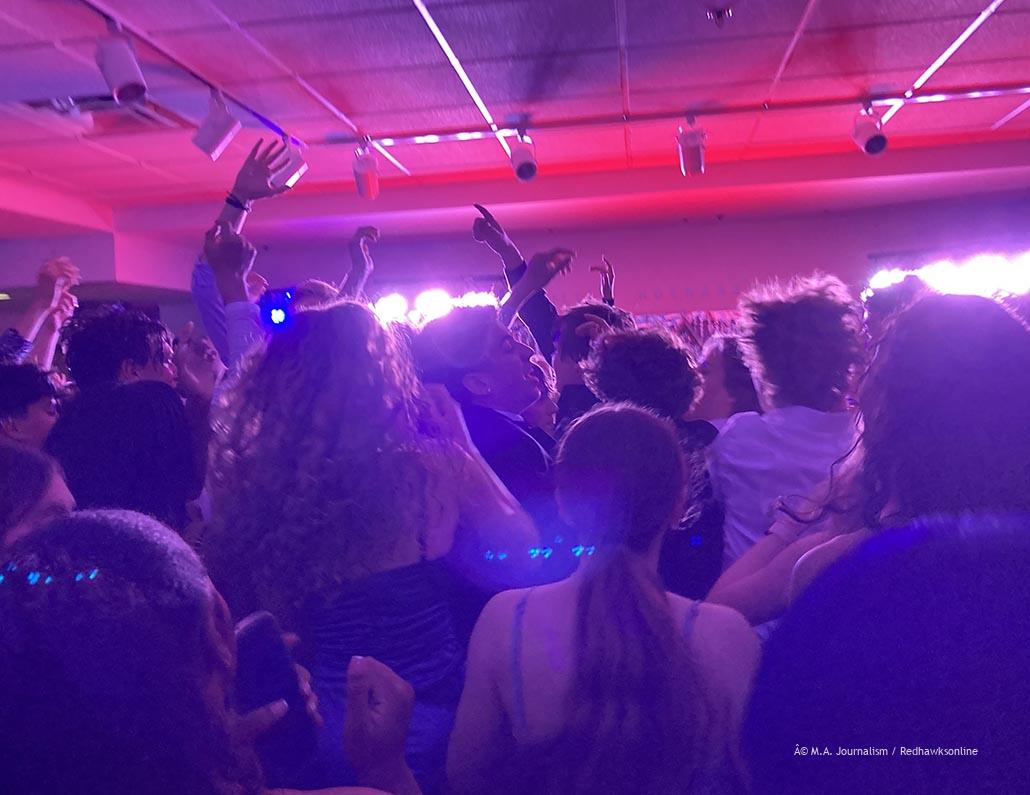The flashing lights. The one moment where everything blinks dark. The spotty flickering of blacklights that make neon and white things glow. The wild jumping and singing. The dance circles.
“They usually have food,” Katie Lehmann, a senior at Minnehaha Academy said. “There was a chocolate fountain one year, too. That was awesome.”
All of these are staples of the Back to School Dance. School dances are a staple to the MA community — and they’re constantly fluctuating. Numerous variables, general and personal, pop up every which way and that: Who goes, who doesn’t, where it is, why it is where it is, what to wear, when to come, what to eat before, who to eat with, who to come with, who to get ready with, what to bring… et cetera. How does one decide? Why even go?
Some students go because they feel societal pressure. “I feel like they’re so lame,” Keara Elwood, a junior at MA, said. “But I think if I don’t go, I’ll miss something that’s so entertaining or something.”
Others because they enjoy it. “It’s a good way to hang out with my friends outside of actually being in classes in school,” Lehmann said. “And it’s a great way to get together and have fun.”
Some simply don’t.
“I don’t go because it’s just kind of a lot of work for something that’s not that important to me, if that makes any sense,” said junior Elise Kostecky. “I just don’t think it’s fun.”
And mostly, school spirit seems to center around dances — which is why one of the most popular dances that’s open to all grades takes place two days after 1st semester starts.
“I think [a)] because people want to get together, school is new, and I think [b)] the venue is on the stage,” said Lance Johnson, Dean of Students at Minnehaha. “Kids really like the backstage dance.”
The backstage, or Back to School dance, is a casual, blacklight, less-stress get-together for students, and an easy way for incoming first year and new students to get a feel for the campus. It’s so effective that most of the MA population goes to each dance.
But it wasn’t always like this. Until 1990, Minnehaha Academy didn’t have dances — it’s only hosted them for 30 years. And what with the explosion of the Minnehaha Upper School in 2017, moving to the old Mendota Campus, COVID-19 in 2020, and social distancing, the dance attendance rates were down for quite some time. We’re talking years. Five or six of them. Lance Johnson, a long-time staff-person of MA, has seen a bit of this in the cycle of attendees throughout MA’s dancing history.
“I’d say 10 years ago, we had everybody coming and then we had a little bit of a lull. Obviously, [the law] maybe had a little bit to do with COVID. We didn’t dance at all at that point,” Johnson said. “But recently, there’s been another upswing where we’re getting pretty good attendance for the first fall dance this year.”
Fifty years ago, in the 1970s, parents organized their own dances for their teens — but who knows what percentage of the school were actually invited. A dance with just your friends? Kind of boring. In this fashion, MA graduates left MA with no memories of the kinds of dances we know today. Julie Johnson has inferred a bit of their feelings: “I think teenagers are teenagers. So it’s not like 50 years ago, teenagers were like, ‘Oh, yeah, we don’t like to dance,’” Julie Johnson said. “I mean, they’re at parties. They liked music, dancing, movies, just like you guys [teens] do.”
In fact, MA students just passed Homecoming week; the last week of September full of spirit days, the Homecoming court, athletics, grade-level competitions, and the Homecoming dance. But this year, the dance was just a touch different than usual. The fifty-year alumni this year — the class of 1974, who will be present at the class of 2024’s graduation — came to the Homecoming dance. But before conclusions are made — they only stayed for a few minutes. Here’s why.
The class of 1974 had their reunion the same night as the dance — but the two events were in completely separate locations. But again, as Julie Johnson noted previously, teenagers are teenagers. Even now, some alumni wanted to see what student life is like currently. So, they came and danced. Plus, who knows if they went to parent-organized events or not.
Alumni or not, MA’s dances won’t change. Of course, the venues might differ. The students certainly will. The music may adjust. But the idea behind the dances won’t. “Since we always have new students at the school each year, I want students to know that EVERYONE grades 9-12 are welcome to come to the MA dances,” Julie Johnson said.
MA isn’t trying to pressure students into going to MA dances. But the environment is always going to be cultivated into a place of welcome, fun, and – of course – flashing lights.

